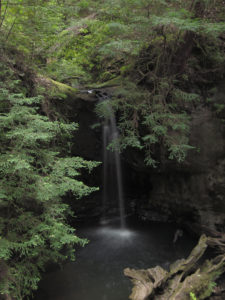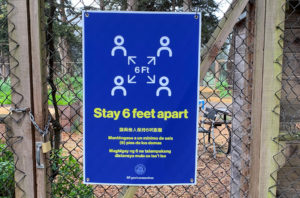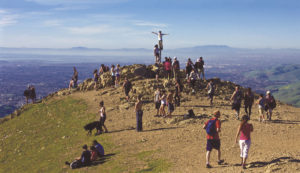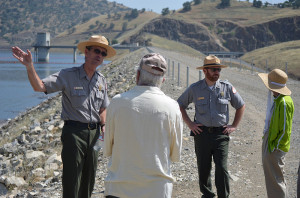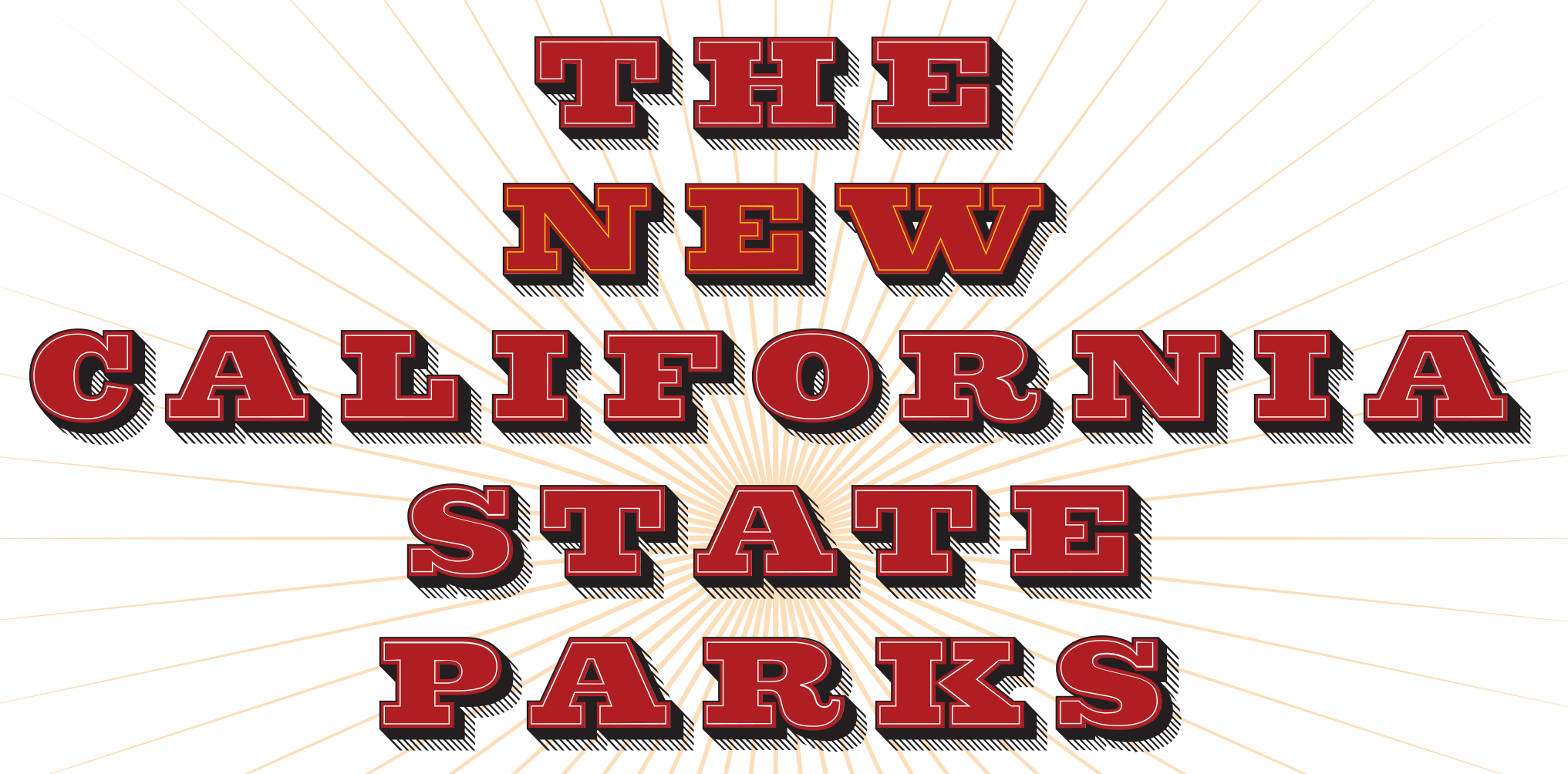
Badges courtesy of Ross MacDonald
On a Sunday afternoon in midwinter, tendrils of thin afternoon light drift through the branches of the oldest avocado tree in Santa Cruz County, illuminating a courtyard carpeted with deep green grass and framed by walls of centuries-old adobe. At a picnic table under the tree, Bella Kressman leads the Meuse family—8-year-old Stella, 3-year-old Skyler, and their parents, Eric and Sarah—through a traditional craft workshop.
They chat as they work. “Have you ever been to an event like this?” Kressman asks.
Eric says no; until today, he didn’t know the historic mission was here at all, though he and his family often camp at the many state parks around Santa Cruz. “Longtime listeners, first-time callers!” he jokes.
It would be easy to find versions of this scene in state parks all over California: community members enjoying well-preserved historical and natural spaces and engaging a little more richly with their world. But look closer and there’s an important difference. Once the family leaves, Kressman goes back into the park store to run the cash register. A sign over her shoulder reads, “Thanks—your purchase supports local state parks and beaches. Get a 15 percent discount by joining Friends today.”
Learn More
Listen to Bay Nature’s podcast “What’s Next For California’s State Parks,” featuring Alissa Greenberg and California State Parks advocates discussing the pressing issues facing the parks system.
In this case “Friends” means Friends of Santa Cruz State Parks. It’s thanks to Friends’ marketing efforts that the Meuse family read about the craft workshop in a local newsletter. Friends runs all the cultural events here at Santa Cruz Mission State Historic Park. It worked with the community to create the park’s rainbow-tiled welcome mural and paid to replace malfunctioning toilets; it also pays Kressman’s salary. Contributions from the general fund to the state parks budget declined nearly 30% in a decade.
Welcome to the “new” California state park, where programming, logistics, and even day-to-day park operations and finances are increasingly outsourced to external groups. These partnerships between the state and more than 100 outside organizations—including nonprofits, for-profits, and other government agencies—support virtually every one of our 280 state parks. Park partners often fundraise and plan activities and educational programming; in some cases, they have signed comprehensive operating agreements that make them responsible for entire state parks—including some 15 in the Bay Area. Which is to say, the guide leading your Sunday hike in all likelihood isn’t an employee of the state.
A nascent version of the park partnership model has been around for almost half a century, but the role of organizations like Friends of Santa Cruz State Parks grew starting in 2011 when a budget crisis threatened to close 70 parks. Santa Cruz Mission State Park was on the list, and Friends stepped up to help operate and keep it open. Per its agreement with the state, the nonprofit makes money from the park store while splitting proceeds from parking, camping, shower, and firewood fees with the California Department of Parks and Recreation. From that income, Friends funds the mission’s lecture series, First Friday events, and the annual Mole and Mariachi festival—all at a park slated for closure just seven years ago.
Statistics on the number of parks run by outside partners vary, but the specifics are less important than the on-the-ground dynamics of those partnerships—especially in the context of California Proposition 68, the Parks, Environment, and Water Bond that will appear on the California ballot June 5, 2018. The proposed bond contains $2.83 billion for parks that would be disbursed over four to five years, including $218 million for existing state parks and significant funding for so-called “park-poor” neighborhoods and affordable coastal accommodation—a sign of the state’s new emphasis on drawing more diverse users to its parks. And it offers $5 million for the exclusive use of outside organizations running entire parks to begin to address a billion dollars in pending park maintenance.
Since the 2011 crisis, the parks department has sought to redefine how state parks are run and whom they are meant to serve in an era when state funding vacillates between uncertain and nonexistent. In theory, a park partnership model brings together parties with unique strengths and welcomes voices traditionally uninvolved in shaping parks policy. But critics argue that a culture clash between the state and park partners, as well as insufficient oversight, have kept those partnerships from living up to their potential. And, regardless, unless the state substantively addresses its maintenance backlog, this new paradigm is unsustainable.

The parks world remembers the golden years fondly, back when money from the state’s general fund and parks bonds approved by voters every four years or so kept the lights on and rangers digging trenches, leading hikes, and patrolling campgrounds. But in the late 1980s, both sources of money began to dry up. Cutting parks funding, which even at its most robust represented a small fraction of the state budget, became a visible way for politicians to signal their tough stance on spending. Finally, after repeated budget cuts surrounding the 2008 recession, funds hit a critical point.
Proposition 21 appeared on the ballot in 2010 to save state parks, proposing an annual $18 addition to vehicle registration fees to cover the department’s operations and ballooning maintenance costs for, as retired ranger Bill Krumbein pointed out to me, “the price of a deluxe pizza.” But the initiative failed, and in January 2011, Sacramento cut the department budget by another $22 million, causing a staffing crisis that compelled Governor Jerry Brown to call for the closure of 70 parks.
At the same time, scandal hit the department. Some $54 million of unreported funds turned up in parks accounts, having accumulated over decades due to an accounting error. Public furor drove Ruth Coleman, director of the parks department, to resign, and funding continued to bottom out. In total, the parks budget covered by the general fund declined from $182 million in the 2000 fiscal year to $121 million in 2011, or nearly 30 percent in a decade. The larger picture is even more grim: the portion of parks funding that came from the general fund declined from 91 percent in 1980 to 28 percent in 2014.
Support from organizations like Friends of Santa Cruz State Parks and the California State Parks Foundation and general public outcry led to new legislation that allowed nonprofit organizations used to supporting roles to take on full responsibility for state parks, a last-ditch attempt to keep those on Governor Brown’s closure list open in arrangements that Resources Legacy Fund president Michael Mantell describes as “held together by bailing wire.” At the same time Mantell and his organization helped set up the Parks Forward Commission, a group of industry outsiders whose goal was to help the department reform financially and remake itself in a time of crisis.
Given the lingering scandal, the commission quickly hired the consulting firm FTI to look over state parks books. In a blistering report, FTI called the department’s financial system “antiquated” and its projected annual funding gap of $100 million “truly alarming.” In 2015, Parks Forward issued a list of recommendations for department improvement, focusing on sustainable funding, a major upgrade in accounting practices, increased focus on parks access for a more diverse swath of Californians—and more emphasis on partnerships.
Other states were having this discussion, too. Bryan Martyn, who ran Arizona State Parks from 2012 to 2015 when the state was forced to close almost half its parks, remembers talking with colleagues at a National Association of State Park Directors conference during that time: “Everybody was trying to figure out, ‘OK, how are we going to make this work?’” he says. (Arizona ultimately went the park partner route as well, contracting with the city of Yuma, a historical society in Flagstaff, and an Indian tribe to run its parks.)
Nationally, the park partnership model is on the rise, according to Eric Hamp of the National Recreation and Park Association. The NRPA works with thousands of state and municipal park agencies, he says, “and many of them are engaged in public-private partnerships.” His organization even has a snappy name for these arrangements: P3s.
“California is America in fast forward … if you’re not broadening access, parks are dead.”
In the P3 ideal—a vision repeated to me again and again as I reported this story—each party contributes its strengths to create the best possible park. The state brings a deeply rooted mission, “to provide for the health, inspiration and education of the people of California….” as well as a century of experience and expertise; it thus maintains infrastructure, stewards the natural and cultural resources of each park, and provides law enforcement. In turn, a nonprofit manages daily park operations and brings a culture of nimbleness and innovation, as well as community ties that tap into the needs of both locals and donors. This last ingredient reflects the fundamental change wrought by park funding woes. Income is essential to the new paradigm, and in some park partnerships it is incumbent upon the outside organization, not the state, to meet a bottom line and ensure a park’s survival. Almost every nonprofit employee I spoke to for this story believed that if it weren’t for their organizations, their parks would be closed.
Many P3s have succeeded in at least this capitalist sense, stabilizing and modernizing parks whose attendance levels were previously semi-comatose. “As a nonprofit it doesn’t take us long to make decisions and make changes,” says Michele Luna, executive director of Stewards of the Coast and Redwoods, which operates Armstrong Redwoods and Austin Creek. “When we started operating, we had a credit card machine in the kiosk within a day. We had Wi-Fi, we bought a truck; all these things we just did without having to have approval processes and get delayed.”
Park partners say their stature and physical presence in their communities helps address that hungry bottom line. The money they bring in stays within their parks, rather than heading to a state fund and trickling back, as it used to; Luna says Stewards’ park users especially appreciate that. Martin Lowenstein, director of Friends of China Camp in Marin County, adds that local nonprofits are better equipped to nurture partnerships with local businesses for “gifts in kind.” He points to a February 2017 storm that washed out a 20-foot section of trail; Friends of China Camp rebuilt the trail using 300 tons of rocks and gravel donated by a local quarry. “I don’t know if state parks can develop those kinds of partnerships from Sacramento,” he says.
The department carefully monitored the rebuilding of that trail; such oversight is central to the P3 model. Every park partner with an operating agreement must document in-depth their operations, financial, and resource management plans annually. Any new project beyond day-to-day work requires a project evaluation form (PEF) signed by the state. “That’s how State Parks keeps an eye on us,” Lowenstein says. He sees their supervision as essential to ensuring that park resources are protected.
With their chimera status, parks run by the likes of Stewards, Friends of Santa Cruz State Parks, and Friends of China Camp challenge conventional state park identity. They take marketing seriously, offer photography classes, host weddings, and throw themed costume parties. Santa Cruz Mission hosts pop-up picnics; Jack London State Historic Park, in Glen Ellen, has become well known for its summer Broadway Under the Stars performances.
These activities might be unconventional, but they’re essential to Jack London Park Partners’ vision of the future of parks, says the group’s executive director, Tjiska Van Wyk. “We could have 30 people come to this park a day, or we could have a month like this November when 8,000 people came. If they come to Broadway Under the Stars, they have that experience. They’re here for the first time and looking around and think, ‘I need to bring my family here.’” Jack London is routinely held up as the poster child for the P3 model. In its first year, JLPP increased the park’s hours, raised parking fees slightly, held more special events—and more than tripled revenue, halving the park’s previous operating deficit.
Each partner contracted to run a state park submits a financial statement as part of its annual review, and the trend is clear: growth. In one year, China Camp’s Reserve America reservations increased some 20 percent, while income from its annual passes increased by 40 percent. At Sugarloaf Ridge State Park in Sonoma County, income from entrance fees increased 75 percent in three years and income from events—led by the park’s popular Funky Fridays concert series—increased 737 percent. And at Jack London, the park continued to make up its operating deficit with fundraising, ending 2017 $400,000 in the red in operations but making up the difference with contributions ($74,000), memberships ($90,000), sponsorships ($54,000), grants ($40,000), and, most significantly, fundraising events ($182,000.)
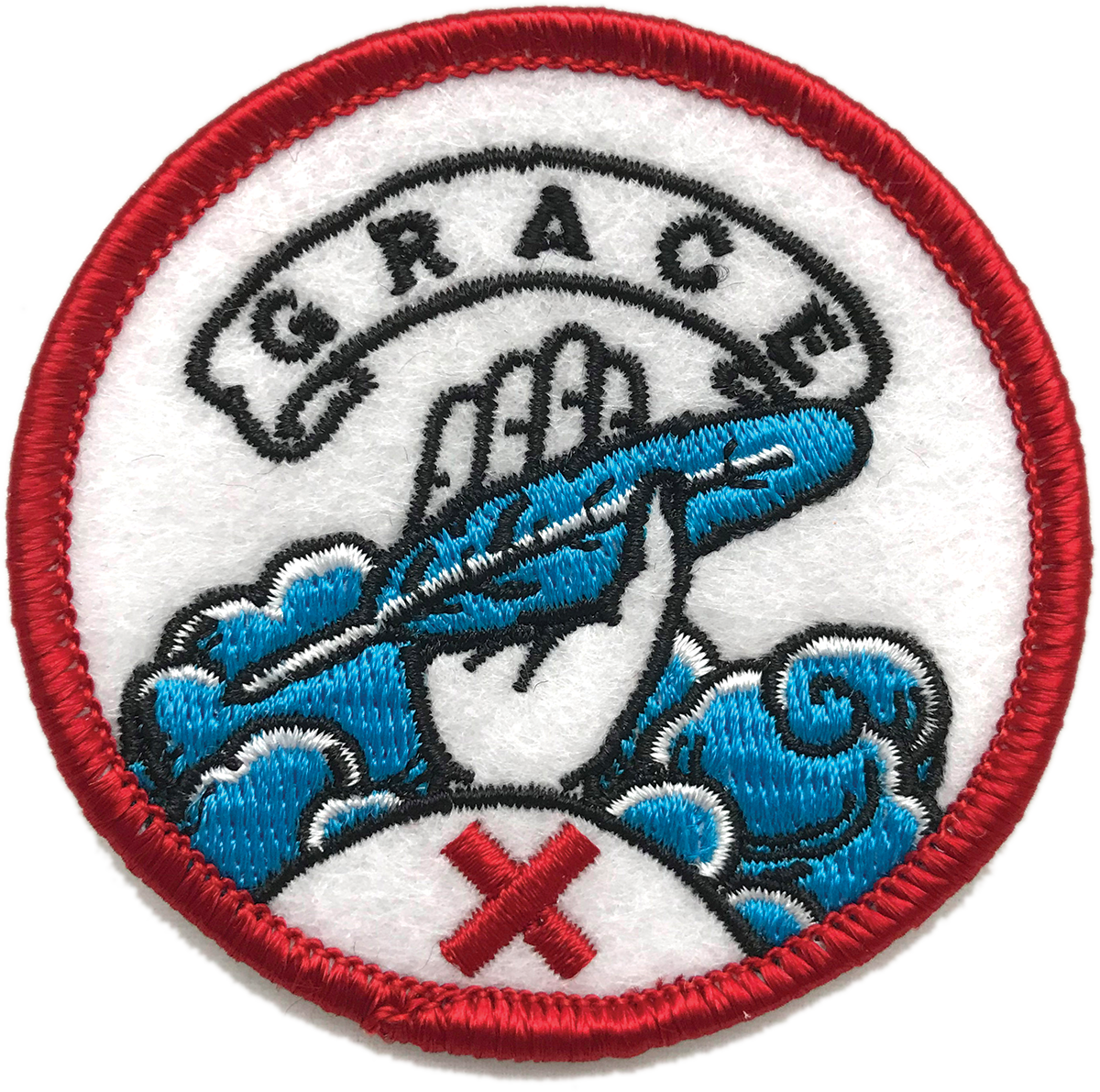
Los Angeles State Historic Park, in the heart of L.A.’s Chinatown, embodies the department’s attempts to transform and push the boundaries of the conventional state park in another way. Many of its users are people of color, and they had a say in its creation: In its infancy, the park borrowed the Latin American “prometores” model of public health, with outreach workers talking to the community about the kind of park that would fit their needs. The result is a state park offering the likes of yoga classes and healthy food workshops. If the Legislature determines the pilot is a success, they’ll repeat it elsewhere; Candlestick Point State Recreation Area in San Francisco may benefit from lessons learned in Los Angeles.
This push is also rooted in Parks Forward’s work. Recognizing that California’s demographics are changing, the commission recommended the department expand its focus from the “traditional”—i.e. older, whiter, richer—park user to include the state’s growing population of younger people of color. Jon Christensen, an adjunct assistant professor of Environment and Sustainability at UCLA who has studied the relationship between communities of color and parks, sees an important trend here: Over the last 20 years, conservation measures at the ballot box in California have passed because they’ve been supported by Latino, Asian-American, and African-American voters, he says, even more so than by white voters and even though the money usually did not create parks where they lived.
Through Parks Forward, the department took notice and decided inclusion ought to be a priority from both a social justice and a policy standpoint. “Los Angeles is California in fast forward, and California is America in fast forward,” says Lance Conn, who sat on the commission. “It’s going to be younger and browner. If those constituents are not engaging with parks, it’s existential. If you’re not broadening access, parks are dead.”
That’s how Parks Now, a coalition of groups like Outdoor Afro and Latino Outdoors, ended up working with the department’s Partnerships Office to increase park access for underserved communities. To that end, Proposition 68 includes a whopping $725 million for parks in neighborhoods that don’t have them (read: urban, poor, lacking public resources), as well as $60 million for low-cost coastal accommodations on both park and conservancy land, since research by Christensen and others showed that the price of hotels or other lodging plays a major part in discouraging low-income communities from visiting California’s beaches.
Ben McCue runs a program called Outdoor Outreach that exposes low-income and refugee youth to the outdoors in San Diego, and his organization is an active member of Parks Now. Although he previously avoided working on his programs with state parks because of their bureaucratic hurdles, he sees the Parks Forward Commission’s emphasis on park diversity as a gesture of good faith. In his work with the department, McCue hopes to create a new kind of partnership.
His idea: What if the department also signed contracts with the Parks Now groups—to bring in young people from underserved communities and help them to learn to love the outdoors—and compensated the groups accordingly? “These are things that the department really can’t do on their own,” he says. “We run programs in Spanish; our staff speak Arabic and Vietnamese. We’re able to connect with the youth we serve and introduce them to the value of these areas in a way that someone who looks like a law enforcement agent—and many times is—couldn’t do.”
The new California State Park forces us to acknowledge our discomfort with the mixing of public and private and begin to interrogate it.
When the dust settled from the 2011 crisis, for-profit companies were running four California state parks. This elicited the most gasps of incredulity from friends and colleagues as I reported this story. The existence of these parks pulls at something deep in the entrails of the idea of public land, and talking about them inevitably leads to a barrage of horrified questions: What kind of system allowed that to happen? Does that mean the park was privatized? What does this mean about the P3 model in general?
Information about California’s privately run state parks is hard to come by. The only solid facts I found are already a few years old: For example, that the camping and outdoor company American Land and Leisure paid $50,269 in rent in 2013 to operate Brannan Island State Park in Sacramento County, some of which money goes to maintenance; in return the company earned $478,751 in income during the same period. But beyond that, parks department staff say the hand-over predated them, and American Land and Leisure didn’t respond to my interview requests.
So, on a winter day, I drive to Brannan Island to see for myself what a for-profit state park looks like. Past the empty entry kiosk and an aging display about area birds of prey, I find a little closed visitor center. Its concrete is stippled with raccoon tracks; its offices are empty but for an ’80s-era cash register, a sign that proclaims “no diving within the state park system,” and the ruins of an exhibit on wetland ecology. Nearby, a little wooden amphitheater with crooked, flaking benches sits roped off with caution tape, overlooking the flat water of the river. The tiny marina is grown over with rosy duckweed.
By the main launch area, I meet Phillip Lees, who has been coming to Brannan Island for 50 years, since before it was a state park. He remembers this place when it was just dunes and says the marina has been closed for at least three years. Still, he sees American Land and Leisure’s tenure as largely positive: The state’s worst crisis years were a “dormant period” for the park, he says, and things improved after the hand-over. Matt Rickard, another camper who’s been coming to the park for more than a decade, says the transition was “fairly seamless.”
Even Ruth Coleman, who was parks department director at the time, doesn’t quite remember how American Land and Leisure ended up with Brannan Island. She guesses the contract was amended during the worst of the budget crisis. “This was an opportunity where we could keep the venue open, people could still go there, and you already had an operator on site,” she says. “They’re better than the state at doing things like boat rentals, and nonprofits aren’t particularly good at that.”
Perhaps therein lies the rub: a for-profit company running a park feels like an extension of allowing any outsiders into the state park system, the result of taking that choice to its logical extreme. The idea taps into our fear that any entity focused on a bottom line, even a nonprofit, couldn’t possibly run or protect a park as it’s meant to be run and protected. But people come to Brannan Island for camping and boating, and Coleman argues that at least in an ideal world, the P3 system lets a partner with relevant expertise do that work.
In finding new solutions for serving parks and their users—regardless of whether those solutions come by way of the state or the nonprofit or for-profit world—the new California State Park forces us to acknowledge our discomfort with the mixing of public and private and to begin to interrogate it. For Conn of the Parks Forward Commission, that means reading between the lines. He remembers a widespread but diffuse unease during the 2011 crisis around the new park partnerships, a discomfort that never quite resolved into specifics. Conn saw something else in those concerns: a fear of change.
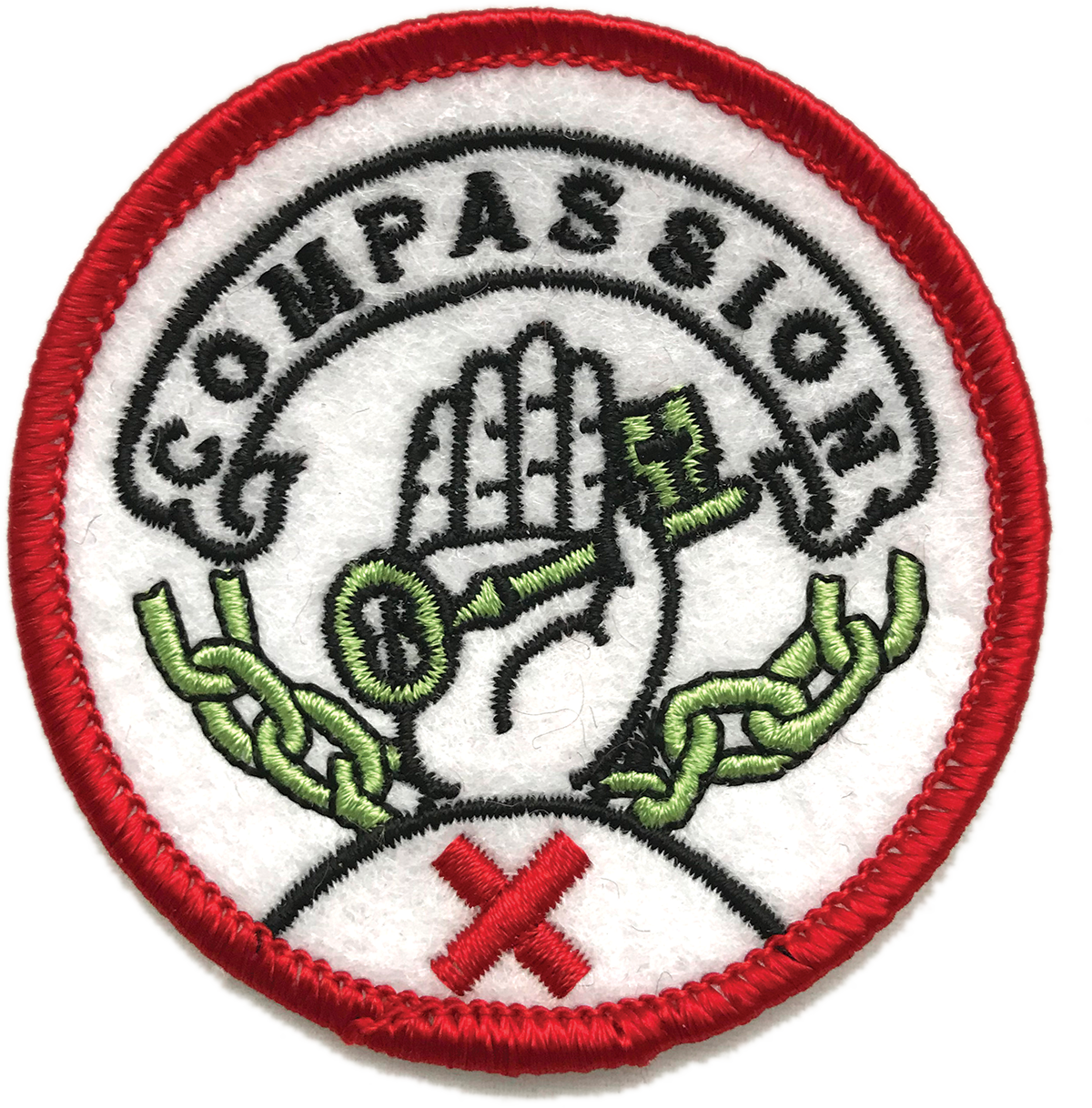
The struggle to change—and its accompanying air of mistrust and tension—is painfully clear in the public records of the last six years. While today both the department and its partners acknowledge “bumps” along the way, there were moments when the new partnerships teetered on the edge of collapse.
A lengthy Failure to Comply warning issued by the department in 2014, as well as supporting documents that followed, shows that the state reprimanded Jack London Park Partners (then known as Valley of the Moon Natural History Association) for allegedly breaking its operating contracts and violating state and federal laws in a number of ways. The warning alleges that among other incidents, Valley of the Moon cleared native brush, created new visitor areas that were not ADA accessible, built a rock retention wall, pruned trees, turned a historic building into an event venue, installed a mural, graded a road, and repaired a culvert—all without the department’s permission or proper permits. The documents cite 13 unauthorized Valley of the Moon projects and alleges 32 counts in which state or federal law—including the Clean Water Act, Environmental Quality Act, and Endangered Species Act—were violated. An executive summary of the state’s investigation of Valley of the Moon recommended “immediate termination” of the organization’s contract.
Records also show the Sonoma Ecology Center, which operates Sugarloaf Ridge State Park, received a Failure to Comply notice two years later. The 2016 notice alleges that SEC cleared vegetation to enable off-road parking, constructed a raised stage and shed, and prepared and sold food without permits or permission—all in service of its Funky Friday concerts, whose audiences were officially limited to 125 people but at their peak were over 500. The letter also notes that SEC redirected a creek tributary without permits and did not remove an unpermitted new picnic facility, despite repeated instructions to do so. Danita Rodriguez, then the parks district superintendent, writes that given all this, she feels that SEC “may not be exerting good faith efforts” to complete its duties as park operator.”
Both Jack London’s Van Wyk and John Roney, the park manager at Sugarloaf since 2012, say most of these allegations were the result of misunderstandings, while others were outright false. “Some things we did in violation were done intentionally; we just didn’t know they weren’t acceptable things to do,” Van Wyk says—like trimming a tree with hanging branches that had recently injured a child. And according to Roney, some of the Sugarloaf alleged infractions were actually SEC addressing problems the department had left unsolved—the “redirected tributary” was another broken culvert, he says, and the graded road was the emergency egress from the park, which had been blocked with fallen trees.
Roney says the Failure to Comply letter came without warning and that the department didn’t communicate its concerns beforehand. He wishes someone had come out to discuss things in person “rather than going to code red”; similarly, Van Wyk remembers that in the first years the department was “understaffed” with “little time available to train us.” She describes that year—which included raising funds from scratch, resolving urgent maintenance issues, and even furnishing empty state park offices—as taxing and exhausting. “I was stressed, angry, frustrated, and tired,” she says. “I think both parties would admit that there wasn’t a whole lot of mutual respect at that time.”
Roney and Van Wyk say that communication eventually improved, with an established schedule of regular phone calls and meetings. Funky Fridays found a new home, and both organizations took steps to resolve the issues raised in their exchanged letters. In September 2016, Rodriguez issued a joint statement with Sugarloaf that said, in part, “SEC and its partners took action to correct issues raised [in] the letter, and there are no outstanding issues at this time.”
A May 2016 update to Jack London’s Failure to Comply letter references the “many conversations” between the department and Valley of the Moon, discussions that Van Wyk says started out fraught but ultimately built trust. Jack London Park Partners retains Valley of the Moon’s contract; she posits that “at the very highest levels nobody wanted to see us kicked out because it could have represented a black eye [for the department].” The solution was those frequent meetings, she says, and a mutual dawning recognition that “both parties have a fundamental love and desire for making these parks exceptional.”
Although the park partnership system was sold as a temporary fix, it’s clear seven years later that P3 is the new reality.
Despite these improvements, concerns about the new system linger. The California State Park Rangers Association (CSPRA, pronounced “sea spray”), a group of about 800 current and retired California parks professionals, has taken up the mantle of watchdog over the past six years, closely monitoring the department and its partners. CSPRA played a role in the Failure to Comply investigation at both Sugarloaf and Jack London, and from its perspective, those cases are yet to be resolved. The organization prepared a lengthy report this winter on continuing park issues that it plans to present to the department.
CSPRA member Bill Krumbein, who worked as a ranger in Sonoma and Napa for 26 years, helped with that report. He feels the urgency to save parks caused the department to lose touch with the “purity” at its foundation. “The highest priority has been placed on a business model for state parks and making money,” he says. “You lose perspective on why you have the state park there.” He mourns a “parks ethos” of warmth, passion, and connection with nature lost somewhere in the melee, and he wonders: Do we really need these shows, events, and parties in our state parks?
For Jeff Price, who heads CSPRA’s “Park Threats” committee, the problem is not the idea of park partnerships, but a lack of oversight and accountability in their execution. The way he sees it, “the district superintendent, the director, they just said, ‘Give them the keys.’”
The most common analysis I heard is that park partnerships engender a cultural and practical mismatch if not executed well. As a government entity, the department moves slowly and presents many layers of bureaucracy before a project can be approved. Nonprofits aren’t used to that pace, especially when the stakes are high both practically and financially. Slowing down to fit that pace can even cause a nonprofit to lose its donor, says Robert Doyle, general manager of East Bay Regional Park District, which operates several state parks. “It happens all the time. When somebody gives you money, they want to see that project done and done well.”
Take Jack London’s culvert repair. The department took issue with Valley of the Moon’s failure to submit a PEF, to get a permit from the Army Corps of Engineers, or to do studies about impacts on the environment or prehistoric artifacts in the area. But the culvert was washed out suddenly in a heavy storm. In a conversation paraphrased in documents from the state’s investigation, Van Wyk asks her interlocutor in a moment of frustration, in effect: Are we supposed to wait and leave the trail closed and impassable for visitors, while we wait a year for the state to approve repairs?
The P3 debate, then, becomes one of purists versus pragmatists. Price and Krumbein maintain that the challenges can be resolved with a champion in the Legislature, an increase in general funding, and more bonds like Proposition 68. “When the governor said we were going to close parks, that’s what we should have done,” says Price. “The Legislature and ultimately California voters needed to see something concrete that would help them change the outcome.”
Conversely, after spending much of his academic career studying the park political ecosystem, Christensen of UCLA has embraced pragmatism; he recently got involved with Los Angeles River State Park Partners. “Yes,” he says of Price’s stance,“in an ideal world, but we’re not there.” In his work at LARSPP, he says, he’s putting “my money and sweat equity where my mouth is.”
Christensen cautions patience to critics who see the Parks Forward process as unproductive; like many people I spoke to, he compared this kind of change to turning a ship around, a sentiment parks Deputy Director Elizabeth McGuirk echoes. “Five years sounds like a long time, but it’s really short in terms of state processes,” she says. “We’re undergoing a culture shift.”

They’ve had some help. The California State Parks Foundation has played an essential facilitator role, first providing pro bono legal support for the five nonprofits that run state parks and then running skill-building trainings and conflict management workshops to help bridge that cultural gap. The work has been so successful that CSPF is now pivoting away from focusing on P3 dynamics, according to Director of Programs and Advocacy Holly Martinez. “They’re at a place where they’re having these conversations without needing additional resources,” she says.
That’s a good thing because although the park partnership system was sold as a temporary fix during the 2011 crisis, it’s clear seven years later that P3 is the new reality; even the department calls them “the way of the future.” Instead, as contracts from the crisis era start to expire, the department is learning from its mistakes—McGuirk acknowledges that the original P3 model was built “under duress”—and evolving.
Starting this year, park partners are signing more detailed and specific “co-management agreements.” The process begins with face-to-face discussions about mutual goals and is followed, ideally, by frequent check-ins and clear delineation of responsibilities, which Van Wyk learned the value of firsthand at Jack London. After the Failure to Comply letter came, “it was like, OK, wait a minute, let’s step back: What actually requires permission?’” she says. “What do we have the authority and responsibility to do?”
Park partners who have had smoother relationships with the department attribute that success to longevity and accrued experience, as well as the kind of consistent communication that eventually helped Jack London and Sugarloaf. Friends of Santa Cruz State Parks, which began in the 1970s and is now considered a pioneer in park partnerships, makes policy decisions with the help of a committee that includes both Friends and department representatives; members discuss park issues and even hold social events for state and Friends employees. This kind of cooperation “reflects how partnerships should work,” says Christina Jaromay, head of the new state park Partnerships Office. “We should never as a state enter into an operating agreement with an entity and turn around and walk away.”
Jaromay’s office is training more park liaisons to provide oversight in the field, but there’s still an essential element missing: money. The department’s budget continues to dwindle. Between 2016 and 2018, it was cut more than 20 percent. Without adequate funding, there may not be enough department staff hours for liaisons to do their work answering questions and smoothing regulatory processes, a limitation several nonprofit employees I spoke with noted with concern. “We might have a cooperative liaison assigned, but is that all that they do?” Jaromay says. “Is it someone who’s really involved, and that’s the majority of their work?”
The question may be moot in the face of the biggest obstacle of all: the department’s massive “deferred maintenance” bill, from decades of broken pipes and crumbling foundations left unaddressed as the budget bottomed out. Price points out the term itself is an oxymoron. “Maintenance implies advanced preventative action,” he says. “It’s actually deferred responsibility.”
The deferred maintenance total costs I find in my research vary wildly. Determined to get information from the source, I experience a moment of cognitive dissonance in conversation with McGuirk and Jaromay, when they simultaneously speak in glowing terms about their new multitier computer system for precisely tracking maintenance costs to the dollar and refuse to specify a total beyond saying it’s “above a billion dollars.” They’re focusing on something called “annual maintenance” for now, they say, using funding from marijuana and transportation legislation.
I try to learn more about what exactly annual maintenance entails, but after my conversation with McGuirk and Jaromay, the department responds to my follow-up questions and interview requests only just as this article is going to print. The data they give me from the new tiered system, difficult to parse through email, seems to indicate that the department is juggling 5,023 deferred maintenance projects totaling slightly less than $1.2 billion. What they don’t say is how they plan to pay that bill.
Meanwhile, virtually every park partner struggles with the realities of deferred maintenance on the ground. At Santa Cruz Mission, Friends relies on fundraising for its most urgent needs, like replacing a blocked French drain this past year (“This whole building is made of mud,” says Amanda Segers, Friends’ Program Manager. “We don’t want it to melt.”). Doyle feels strongly about the matter, calling this kind of obligation an “unfair burden.” Take Lake Del Valle, which East Bay Regional Park District operates for the state and which attracts 400,000 visitors a year. “The water system was built in 1960, and we can’t patch it anymore,” he says. “That’s probably three million dollars. Should we spend that money to replace what the state built?”
I ask Conn, who has made a career in finance, if, with deferred maintenance, the P3 system is sustainable. “Well, it’s more sustainable than the alternative,” he says. Neither he nor anyone else I spoke to is sure what the answer is here, but they are emphatic that Proposition 68 is a start. The bond’s $218 million for existing state parks could be put toward maintenance, and the $5 million will give operators the opportunity to address urgent issues themselves. It also sets a precedent of enabling bonds to earmark money explicitly for park partners, paving the way for future funding.
And yes, a change in leadership in Sacramento wouldn’t hurt. A commonly repeated statistic points out that one year of parks funding is one-tenth of one percent of California’s budget.
The funding “is there,” Krumbein says. “It’s just not pointed toward us.”
It’s a clear day at China Camp State Park near the city of San Rafael, and San Pablo Bay is slate blue and gently ruffled. The park is filled today with mountain bikers and families wandering the ruins of the last Bay Area Chinese shrimping village. Dogs run in the waves; a few curious onlookers squint at the replica Chinese junk tied to the ramshackle pier.
Friends of China Camp’s Martin Lowenstein walks the beach and the ruins of the village, its corrugated metal roofs glinting, walls endlessly patched. He shows me the ten-or-so pilings holding the old houses up over the Bay that urgently need to be replaced. One has a hole clear through it with a view to the sand on the other side. He says he hopes people in the community will help him raise funds for it where the department has not. The local harbormaster offered to do it for a deep discount, “but it’s not that simple,” he says. He knows he will have to submit a PEF and get the project authorized. Who knows how long that would take?
For now, Lowenstein and his programming director, Sheila Coll, are doing their best with the resources at hand, as they push to put the department’s broader transformation efforts into action on a local level. Coll says her plans for the future of China Camp include programs on the park’s indigenous history that will bring in community members from the Canal district, a nearby area with large low-income Latino populations. She’s especially excited about working with a local facilitator for blind and sight-impaired groups on a tour of the park that focuses on the senses, including a pause to smell native plants and the dried shrimp the village once produced.
We stop at the old snack bar, which until 2016 was run by Frank Quan, the last of China Camp’s residents. “Fresh cooked crabs, sandwiches, fresh shrimp cocktails,” a faded sign says. Next to it, a paper tacked to the window: “in transition due to Frank Quan’s passing.”
The cafe is just as Quan left it, with his menu still written on a white board. His friends continue to gather on Saturdays to drink coffee and eat doughnuts on the old wooden bar. “This was and is a community hub,” Lowenstein says. The daffodils Quan planted still bloom outside his cafe, as if in reminder.

